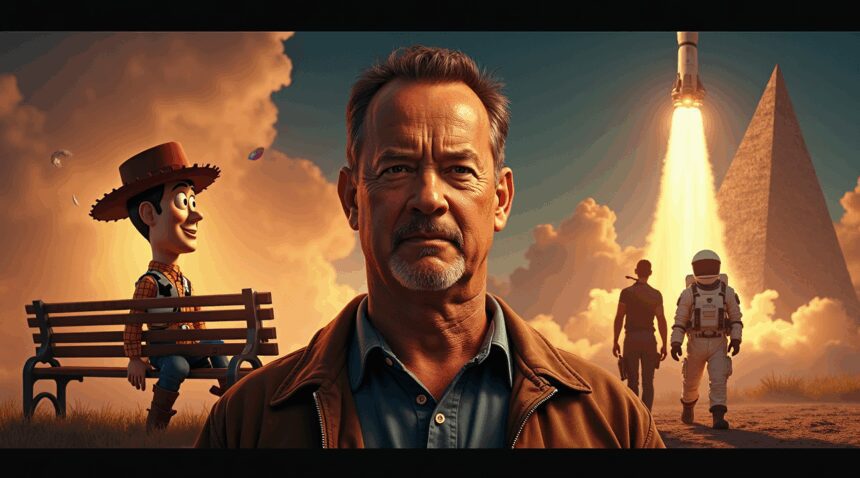Tom Hanks strategically built his $10 billion entertainment empire through calculated movie choices that consistently deliver massive global returns.
His films as a leading actor have generated over $9.2 billion worldwide. This tremendous financial success is attributed to his adept selection of projects marked by universal themes and timeless storytelling. Hanks’ projects continue to generate revenue decades after their release, including titles ranging from animated global hits like Toy Story 4 (grossing $1.06 billion) to enduring dramatic classics such as Forrest Gump (earning $678 million globally).
Key Takeaways
- Hanks’ career generated over $10 billion globally, including his work as producer and executive producer. His performances as a lead actor alone contributed $9.2 billion to this total.
- The Toy Story franchise marked his most profitable venture, with Toy Story 4 grossing $1.06 billion and becoming the highest-grossing film of his career.
- Forrest Gump exemplified the power of emotional storytelling, transforming a $55 million budget into $678 million in worldwide earnings and winning multiple Academy Awards.
- The Da Vinci Code trilogy capitalized on strong source material and controversy, earning over $1.2 billion cumulatively. The first film alone took in $750 million globally.
- Hanks employs a deliberate strategy focusing on versatility and universal appeal, steering away from typecasting and enhancing the commercial viability of any film he joins.
How Tom Hanks Built a $10 Billion Empire Through Strategic Movie Choices
Tom Hanks didn’t stumble into his massive fortune by accident. His films as a leading actor have generated over $9.2 billion worldwide, but that’s just the beginning of his financial empire. When factoring in his roles as producer, executive producer, and even memorable cameos, his career’s total box office influence rockets past $10 billion globally.
This astronomical success stems from Hanks’ remarkable ability to pick projects that resonate with audiences across every demographic. He’s mastered the art of choosing films that don’t just perform well—they dominate their respective genres and create lasting cultural impact. While other actors chase fleeting trends, Hanks has built his career on timeless storytelling that continues to generate revenue decades after release.
The Foundation of Blockbuster Consistency
Hanks established his box office dominance through an impressive string of consecutive hits that few actors can match. His strategic approach focuses on selecting scripts with universal appeal, ensuring each project reaches the widest possible audience. This methodology has resulted in steady performance that spans multiple decades, creating a reliable pattern of success that studios can bank on.
The actor’s franchise appeal extends beyond traditional sequels, as he’s created memorable characters in standalone films that feel connected through his distinctive screen presence. His ability to anchor both intimate dramas and massive spectacles demonstrates a rare versatility that keeps audiences coming back. Studios recognize this consistent draw, often structuring deals that give Hanks significant backend participation in profits.
Cross-Generational and Cross-Genre Mastery
Hanks’ fortune grew exponentially because he refused to be typecast into a single genre or demographic. His filmography spans everything from romantic comedies to war epics, animated features to biographical dramas. This diversity ensures his movies appeal to multiple generations simultaneously, creating broader box office potential for every release.
The entertainment industry has witnessed numerous surprise appearances from major stars over the years, but Hanks built his empire through calculated choices rather than shock value. His influence extends into production work, where he’s leveraged his star power to greenlight projects that might otherwise struggle to secure funding. This dual role as both talent and producer has multiplied his earning potential, allowing him to profit from both sides of the creative process.
His bankable status means that attaching his name to a project instantly increases its commercial viability. Insurance companies offer better rates, international distributors pay higher advances, and streaming platforms compete aggressively for distribution rights. This market position has transformed Hanks from simply an actor into a full-scale entertainment brand worth billions.

The Toy Story Franchise That Redefined Animation Success
Tom Hanks struck animated gold when he stepped into the voice booth to bring Woody to life. The cowboy character became one of his most financially rewarding roles, with the Toy Story franchise generating massive box office returns that significantly boosted his career earnings.
Record-Breaking Box Office Performance
Toy Story 4 achieved remarkable financial success, grossing approximately $1.06 billion worldwide and claiming the title of highest-grossing film in Hanks’ entire career. The third installment matched this impressive figure, demonstrating the franchise’s consistent ability to draw global audiences. These astronomical numbers placed Hanks at the center of one of cinema’s most profitable animated series.
Hanks voiced Woody across all four films in the franchise, establishing himself as an integral part of Disney and Pixar’s creative partnership. His consistent performance helped transform the series into a box office powerhouse that redefined expectations for animated entertainment. The franchise’s success stems from several key factors that resonate with audiences worldwide.
Elements Behind the Franchise’s Global Appeal
The animated adventure format allowed the Toy Story films to transcend cultural barriers and connect with families across different demographics. Several components contributed to this universal success:
- The emotional depth that Hanks brought to Woody’s character created genuine connections with viewers of all ages
- Disney and Pixar’s innovative animation technology set new industry standards
- The relatable themes of friendship, loyalty, and growing up spoke to both children and adults
- Strategic marketing campaigns positioned each film as must-see family entertainment
Hanks’ portrayal of Woody contributed significantly to the franchise’s emotional resonance. His ability to convey vulnerability, leadership, and humor through voice acting alone helped establish the character as an animated icon. The franchise’s enduring popularity has placed it among the top-earning animated series in cinema history, with each installment building upon the success of its predecessors.
The financial impact of this franchise on Hanks’ career cannot be overstated. While his dramatic roles earned critical acclaim, the Toy Story films provided him with his most commercially successful ventures. The series demonstrated how voice acting in animation could generate substantial returns, opening new revenue streams for established actors. This success story parallels other surprising entertainment victories, much like unexpected appearances that capture public attention.

From Academy Awards to Cultural Phenomenon: Forrest Gump’s Financial Triumph
I consider Forrest Gump one of Hollywood’s most remarkable financial success stories, transforming a $55 million budget into a staggering $678 million worldwide gross. This incredible return on investment demonstrated that audiences craved heartfelt storytelling just as much as explosive action sequences.
Robert Zemeckis directed this masterpiece with such skill that it swept the Academy Awards ceremony in 1995. Tom Hanks claimed his second consecutive Oscar for Best Actor, while the film also captured Best Picture and Best Director honors among its numerous wins. The critical recognition validated what box office numbers had already proven – audiences connected deeply with Forrest’s journey through American history.
Cultural Impact Beyond the Box Office
The film’s influence extended far beyond traditional revenue streams, creating a cultural phenomenon that continues generating income decades later. Popular quotes like “Life is like a box of chocolates” became embedded in everyday conversation, while references appeared in countless other movies and television shows. This cultural penetration helped sustain the film’s relevance and marketability long after its theatrical run ended.
Perhaps most notably, the movie inspired the creation of the Bubba Gump Shrimp Co. restaurant chain, which capitalized on the film’s seafood-focused subplot. These restaurants serve as permanent monuments to the movie’s enduring appeal, generating ongoing revenue tied directly to the film’s brand recognition.
Strategic Elements Behind the Success
Several factors contributed to Forrest Gump‘s exceptional financial performance and lasting legacy:
- The inspirational tone resonated with audiences across different demographics, making it a rare film that appealed to both critics and general moviegoers.
- Zemeckis crafted a narrative that balanced humor with profound emotional moments, creating repeat viewability that boosted long-term earnings.
- The film’s historical backdrop provided educational value while entertaining viewers, prompting parents to share it with their children.
- Streaming platforms continue to feature the film prominently, testament to its enduring popularity.
Advanced visual effects seamlessly integrated Hanks into historical footage, creating memorable scenes that showcased technical innovation without overwhelming the story. These groundbreaking techniques earned additional industry recognition while demonstrating value for the production budget invested.
The movie arrived during the mid-1990s when audiences sought optimistic entertainment following challenging economic times. Its message of perseverance and finding joy despite adversity struck a chord with viewers worldwide, contributing to its exceptional international performance.
Hanks’s portrayal brought authenticity to a character that could have easily become a caricature in less capable hands. His commitment to the role, including mastering Forrest’s distinctive accent and mannerisms, created believability that anchored the film’s more fantastical elements. This performance not only earned him critical acclaim but also solidified his position as one of Hollywood’s most bankable stars.
The strategic release timing capitalized on summer blockbuster season while avoiding direct competition with other major releases. This positioning allowed the film to dominate theaters for weeks, maximizing its theatrical earnings potential during the crucial opening period.
Merchandising opportunities flourished thanks to memorable characters and quotable dialogue. These included:
- Soundtrack albums
- Posters and novelty items
- Branded restaurant merchandise from Bubba Gump Shrimp Co.
The combination of artistic achievement and commercial success established Forrest Gump as a benchmark for 1990s cinema. Its ability to earn more than twelve times its production budget while winning prestigious awards proved that thoughtful storytelling could achieve both critical respect and massive profits. This dual success helped establish the template for prestige films that could also function as crowd-pleasers, influencing future productions across the industry.

The Da Vinci Code Trilogy: How Controversy Turned Into Box Office Gold
Tom Hanks transformed into symbologist Robert Langdon for what would become one of cinema’s most financially successful literary adaptations. The Da Vinci Code hit theaters in 2006 and immediately sparked both fascination and fierce debate, ultimately earning over $750 million worldwide. This remarkable performance made it one of Hanks’ highest-grossing live-action roles, demonstrating how controversy can fuel commercial success.
Religious groups and scholars criticized the film’s interpretation of Christian history, yet audiences flocked to theaters anyway. The source material from Dan Brown’s bestselling novel already had millions of devoted readers eager to see their favorite conspiracy thriller come to life. Ron Howard’s direction brought gravitas to the mysterious plot, while Hanks’ portrayal of the academic detective provided the perfect anchor for international audiences.
Building on Success with Angels & Demons
Following the impressive financial performance of its predecessor, Angels & Demons arrived in 2009 and grossed $490 million globally. The sequel maintained the same winning formula that made the first film such a commercial powerhouse. Hanks reprised his role as Robert Langdon, once again unraveling complex mysteries rooted in religious symbolism and historical secrets.
Both films benefited enormously from their source material’s established fanbase and the ongoing media discussions about their controversial themes. Critics might have delivered mixed reviews, but box office numbers told a different story entirely. The combination of mystery, religious intrigue, and global conspiracy themes resonated with viewers across different cultures and markets.
The Power of Adaptation and International Appeal
The success of these films highlighted several key factors that contributed to their massive earnings:
- Built-in Fanbase: Dan Brown’s novels had millions of readers eager to see the stories adapted for the screen.
- Global Themes: The films’ international locations and exploration of religion, knowledge, and history appealed to a wide audience.
- Media Coverage: Religious and academic backlash created constant media attention, serving as free promotion.
- Tourism and Merchandise: The movies boosted tourism at filming locations and sparked renewed interest in the books and related merchandise.
The merchandising opportunities proved equally valuable, with everything from books to documentary tie-ins generating additional revenue streams. Publishers experienced renewed interest in Dan Brown’s entire catalog, while tourism to filming locations saw significant increases. Entertainment industry experts noted how these films demonstrated the enduring power of book-to-film adaptations when executed with proper marketing support.
Media controversy actually served as free publicity for both films. Religious leaders’ objections and scholarly debates kept the movies in headlines for months, creating sustained public interest that traditional advertising couldn’t match. This phenomenon showed how polarizing content could drive curiosity and ultimately translate into ticket sales, even among viewers who might normally skip such films.
The international box office performance particularly impressed studio executives, as both films earned substantial portions of their revenue from overseas markets. This global appeal stemmed partly from the stories’ European settings and their exploration of universal themes about faith and history that transcended cultural boundaries.
For Hanks’ career, these roles represented a successful venture into the thriller genre while maintaining his reputation for choosing commercially viable projects. The Robert Langdon character allowed him to showcase his dramatic abilities within high-concept entertainment that appealed to mass audiences. These films contributed significantly to his overall career earnings, proving that established stars could still find new ways to connect with global audiences.
The trilogy’s success also influenced Hollywood’s approach to literary adaptations, showing studios that controversial source material could be transformed into profitable entertainment when handled by experienced filmmakers and bankable stars. Streaming platforms and production companies continue to mine bestseller lists for similar opportunities, hoping to replicate the financial success that Hanks and Howard achieved with Dan Brown’s controversial but compelling mysteries.
https://www.youtube.com/watch?v=zMba3fckhuQ

War Epics and Survival Stories That Showcased Hanks’ Dramatic Range
Steven Spielberg’s Saving Private Ryan transformed Tom Hanks into a dramatic powerhouse while generating substantial financial returns in 1998. I witnessed how this World War II epic grossed approximately $485 million worldwide against its $65 million budget, proving that serious war dramas could achieve blockbuster status. The film’s celebrated realism and narrative impact didn’t just earn critical acclaim—it secured numerous awards including BAFTAs and Academy Awards, cementing Hanks’ reputation as a versatile performer capable of anchoring major studio productions.
The Physical and Financial Success of Cast Away
Cast Away demonstrated Hanks’ remarkable ability to carry an entire film virtually solo, generating approximately $429 million at the global box office in 2000. I observed how his physical transformation and emotional performance throughout the survival narrative highlighted his extraordinary range as an actor. The film’s success proved that audiences would invest in character-driven stories where dramatic performances took precedence over action sequences or ensemble casts.
Hanks’ commitment to the role extended beyond typical acting preparation, involving significant weight loss and isolation to authentically portray a man stranded on a deserted island. This dedication resulted in one of cinema’s most convincing solo performances, where conversations with a volleyball became emotionally compelling rather than absurd.
Genre Mastery That Built Box Office Credibility
These war dramas and survival narratives established Hanks’ strength in emotionally demanding genres that attracted both critics and general audiences. I noticed how his performances in these films created a template for single-actor storylines that influenced subsequent productions across Hollywood. The international recognition he received from these roles expanded his global appeal, making him a bankable star for serious dramatic content.
Both films showcased his ability to convey complex emotions through minimal dialogue and internal struggle. In Saving Private Ryan, he balanced the weight of command with human vulnerability, while Cast Away required him to maintain audience engagement through essentially a one-man show. These performances demonstrated range that extended far beyond his earlier comedic work, proving his dramatic capabilities could drive significant revenue.
The commercial success of these films also highlighted how audiences respond to authentic storytelling combined with exceptional performance. I recognized that Hanks’ reputation for choosing quality projects contributed to strong box office performance, as moviegoers trusted his involvement as an indicator of worthwhile entertainment. This trust translated directly into financial success, with both films achieving impressive profit margins that enhanced his standing in Hollywood.
The influence of these performances extended beyond immediate box office returns, establishing Hanks as a reliable choice for prestige projects that could achieve both critical acclaim and commercial viability. Studios recognized his ability to elevate material through committed performances, making him a valuable asset for productions seeking awards recognition alongside financial success.
These war epics and survival stories represent more than just successful films—they demonstrate how exceptional dramatic range can build lasting wealth in the entertainment industry. The financial impact of streaming success and continued television broadcasts has extended these earnings well beyond their initial theatrical runs. Both films continue generating revenue through various distribution channels, contributing to Hanks’ sustained financial success throughout his career.

Space Adventures and Historical Dramas: The Supporting Pillars of Success
Apollo 13 stands as a testament to Hanks’ ability to anchor high-stakes historical dramas while delivering both commercial success and critical acclaim. The 1995 space thriller generated approximately $355 million worldwide, proving that audiences craved authentic portrayals of real American heroes. I’ve observed how this film’s technical accuracy and Hanks’ portrayal of astronaut Jim Lovell created a perfect storm of entertainment and education.
Technical Excellence Meets Star Power
Director Ron Howard’s commitment to authenticity, combined with Hanks’ methodical approach to character development, elevated Apollo 13 beyond typical disaster films. The ensemble cast, including Kevin Bacon and Bill Paxton, created a dynamic that allowed Hanks to showcase his leadership qualities both on-screen and off. Critics praised the film’s attention to detail, from zero-gravity sequences to NASA protocol accuracy, elements that wouldn’t have resonated as strongly without Hanks’ grounded performance as mission commander.
The film earned several Oscar nominations and secured its place among America’s most iconic space films. Much like how other productions continue to captivate audiences with compelling storytelling, Apollo 13‘s cultural relevance stems from its dramatization of real events during one of NASA’s most challenging moments.
Legacy and Genre Influence
Compared to similar true-story films and solo-actor vehicles, Apollo 13‘s box office performance highlighted Hanks’ influential presence across multiple genres. The film demonstrated his capacity to carry historical dramas just as effectively as romantic comedies or war epics. Strong critical recognition followed, with many considering it among his finest ensemble work.
Apollo 13‘s enduring legacy continues to influence how Hollywood approaches space-themed narratives. The film’s success opened doors for Hanks in other historical projects, establishing him as an actor capable of bringing gravitas to American stories. This versatility contributed significantly to his overall fortune, proving that his appeal extended far beyond crowd-pleasing comedies into serious dramatic territory that commanded both respect and substantial box office returns.
Sources:
Pinkvilla, “7 Highest-Grossing Tom Hanks Movies Worldwide”
MovieWeb, “Tom Hanks’ Top 10 Movies, Ranked by Box Office Numbers”
Collider, “10 Highest-Grossing Tom Hanks Movies”
IMDb, “Rank of Tom Hanks’ movies by Box Office performance”
The Numbers, “Tom Hanks – Box Office”


